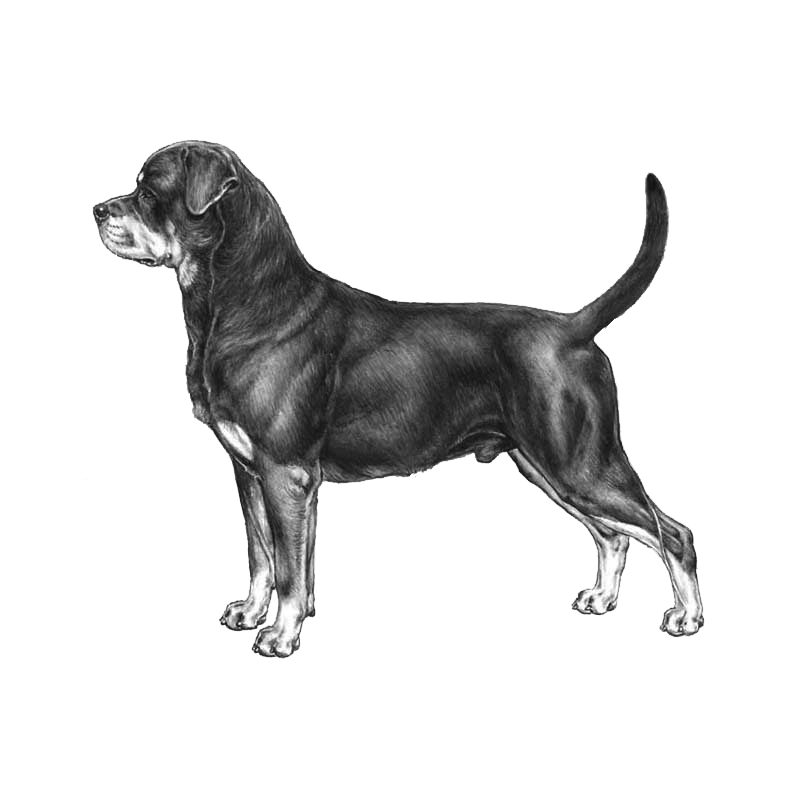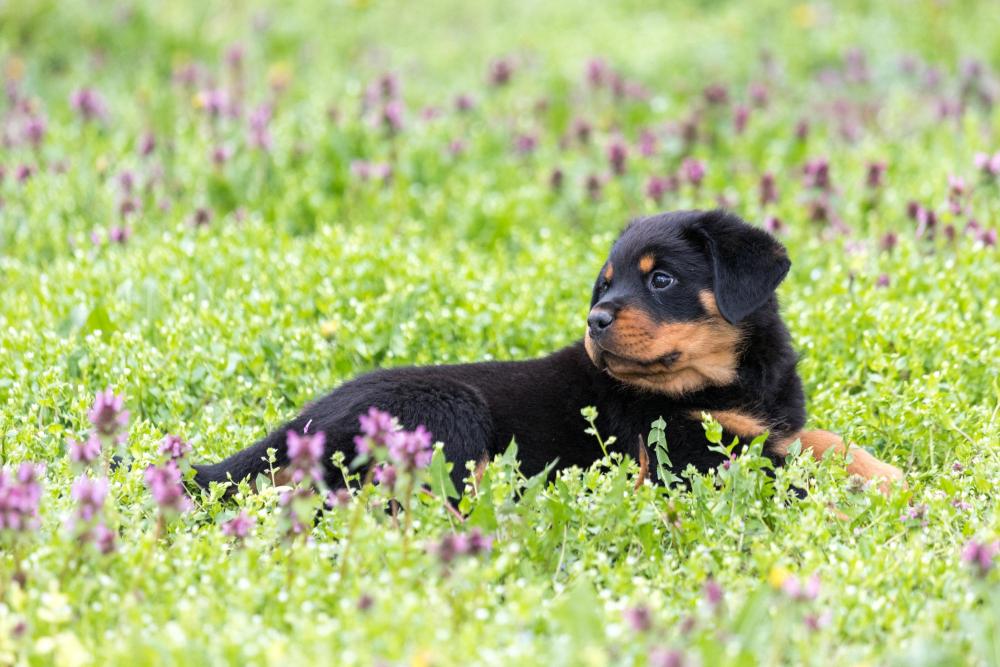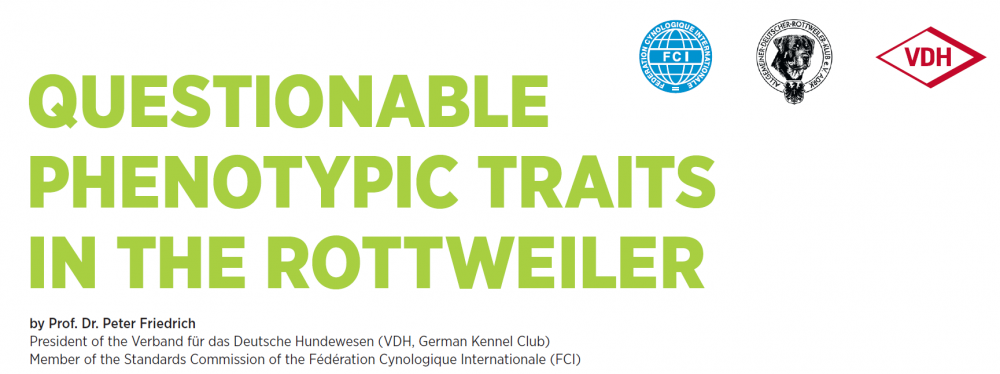
These Mastiff-type dogs stem from animals taken to Germany by Roman soldiers as they marched across Europe. Used to guard livestock, they were either discarded as the cattle were eaten or were left to guard outposts, and many finished up in Switzerland while others reached southern Germany. They were especially known around the town of Rottweil, which for 1,800 years was a centre for livestock trading. The evolving dog became a butcher’s dog, drover and draught dog.
The Rottweiler, which first appeared in Britain in 1936 and was shown at Crufts the following year, is an above average-sized, very agile, black-and-tan dog. Extremely strong and imposing, he is easily obedience trained and is, in fact, a dog that enjoys working. He has natural guarding instincts, but is not aggressive by nature. His expression is tranquil and kind, but when aroused, he will hold his own with any opponent. He is not a dog for the inexperienced and has been much maligned in recent years, when the breed became over-popular, and Rottweilers were often purchased to feed a macho image.
Brief Description
He is a very active dog that needs plenty of exercise, but his smooth coat requires only short periods of regular grooming to keep it in the desired shining condition.
Source: https://www.thekennelclub.org.uk/search/breeds-a-to-z/breeds/working/rottweiler/
Links to Breed Descriptions
American Rottweiler Club: AKC Illustrated Standard
See: The German Kennel Club (VDH) for information and video (if available).
(Hint: your browser should be able to Translate to English, at least for text (e.g., right click in Google Chrome or Internet Explorer).)
http://www.vdh.de/welpen/mein-welpe/rottweiler
Video (link - https://youtu.be/1RVecYjNg7E😞
This and other breed videos are available in full length here: www.meisterpetztv.de
AKC Video (link - https://youtu.be/Nf6t-2H28no😞
View more videos on AKC's YouTube Channel: https://www.youtube.com/user/AmericanKennelClub
SCC Video (link - https://youtu.be/U09PCw3LnyA😞
View more videos on SCC's YouTube Channel: https://www.youtube.com/channel/UCKR90_uWp8dUNpGTfQ_y_Zw
Other Names for Breed
Country of Origin and Parent Breed Club
Country of origin: Germany
Parent breed club: Allgemeiner Deutscher Rottweiler-Klub e.V.: http://adrk.de/index.php/de/
Health and Well-Being
Some sources of health information include:
-
National kennel clubs and breed clubs (see, e.g. Breeding/Health Strategy Documents, below)
-
Population-level statistics (see, e.g., Swedish Insurance Data, below)
-
Research articles
-
Breed club surveys
Breed-Specific Articles
Many thanks to DWN content partner Barbara Thiel for sharing this article which was published in “Unser Rassehund”, 09 / 2018!
More Info
Excerpt...
"A genuine Rottweiler stands for a high ideal. With its particular physique, locomotion and behavioural characteristics, such a dog is predestined for a fulfilled life with a family, gratifying results in utility dog and tracking dog trials and successful service as a rescue dog, a police dog or in another important role. Being able to lead such happy and productive lives depends on numerous criteria: dogs must be eager to work, but also relaxed and able to calm themselves quickly. They must be capable of learning, and they need social skills, strength, physical stamina, mental resilience and exceptional agility in young years and later in life. And they must have not traits which stand in the way of achieving this.
This brings us to the topic of the next two sections. Some anatomical characteristics are essential for the social behaviour, behaviour in action and versatility of the Rottweiler, but others are entirely incompatible with it. While this might initially sound like the beginning of a piece of architectural criticism, the anatomy of the Rottweiler’s head is a rather critical issue for reasons which will be outlined below..."

 See the full article which offers information on valuable breed traits, comments on the "Redesigned Rottweilers with extreme characteristics..." i.e. the impacts of trendiness supported by media and human motivations to possess special, extravagant and innovative dogs. Prof. Dr. Peter Friedrich covers recent F.C.I. breed standard revisions adopted to clarify functional aspects sought in the breed (including the complex of traits of concern in the head area) and comments on application of the JLPP test and other factors that impact genetic diversity, health and welfare of this breed. A beautifully written, thought provoking article that provides not only insights into management of the Rottweiler breed but serves to educate breed health managers and breeders for all breeds.
See the full article which offers information on valuable breed traits, comments on the "Redesigned Rottweilers with extreme characteristics..." i.e. the impacts of trendiness supported by media and human motivations to possess special, extravagant and innovative dogs. Prof. Dr. Peter Friedrich covers recent F.C.I. breed standard revisions adopted to clarify functional aspects sought in the breed (including the complex of traits of concern in the head area) and comments on application of the JLPP test and other factors that impact genetic diversity, health and welfare of this breed. A beautifully written, thought provoking article that provides not only insights into management of the Rottweiler breed but serves to educate breed health managers and breeders for all breeds.
 JLPP in Rottweilers - Dr. Perter Friedrich.pdf
JLPP in Rottweilers - Dr. Perter Friedrich.pdf
This article discusses the disease, its genetics, and availability of DNA testing as well as breeding advice.
The article was made available in June of 2017 in Dogs Queensland The Queensland Dog World which can be accessed at...
The discovery of genetic causes of this disease (a monogenic autosomal recessive disorder) and subsequent development of a DNA test along with Dr. Friedrich's clear and concise explanation of genetics includes presentation of graphics with text of Pairing example 1 - homozygous normal X homozygous normal; Pairing example 2 - homozygous unaffected X heterozygous and finally Pairing example 3 - heterozygous X heterozygous. This article on JLPP clearly illustrates how this disease is produced and how it can be avoided which is very helpful to breeders who must implement a sound strategy to produce unaffected pups. JLPP - the DNA test has been recommended or required by breed clubs and appears to be one example of a solidly understood DNA test embraced by the breed fancy.
 On the Origins of Breed Types by Means of Human Action-Peter Friedrich - a 4th IDWH presentation.
On the Origins of Breed Types by Means of Human Action-Peter Friedrich - a 4th IDWH presentation.
ON THE ORIGINS OF BREED TYPES BY MEANS OF HUMAN ACTION - Slides from Peter Friedrich's plenary talk from the 4th IDHW, Windsor, 31 May 2019.
Breed Standards
There are numerous breed standards.
The basis of breed/conformation shows is the judging of pedigree dogs against the 'Breed Standard', which is a picture in words that describes the range of features that are deemed appropriate for the breed.
Three of the major international standards are:
The American Kennel Club
The Kennel Club, UK
FCI (Federation Cynologique Internationale)
Breed-Specific Statistics
1. Swedish Insurance Data
-
Breed-specific information on rates of disease and death from Agria Pet Insurance (Agria Djurförsäkring) is available for many breeds.
This breed has information on Veterinary Care and Life Insurance.
2. Finland: FKC Database: https://jalostus.kennelliitto.fi/frmEtusivu.aspx?R=147
Breeding/Health Strategy Documents
Health/Breeding Strategy Documents and Links:
-
The Kennel Club, UK: Breed Watch (Category 2)
-
Sweden: Breed-specific Breeding Strategies: (in Swedish) and/ or English summary
-
Finland: Jalostuksen tavoiteohjelma Rottweiler
-
US: OFA: Recommended Health tests: https://www.ofa.org/recommended-tests?breed=RO
-
Please Note: US based ADRK affiliated Club's health tests recommendations/requirements may vary from the AKC Parent Club's/OFA's health test recommendations.
HEALTH SURVEYS
Finland: the Processing committee in 2018 created a summary of a rottweiler health, based on existing Koiranet data in the official investigation results, and the owners made by cause of death notices. The Health summary was published Rottweiler magazine 4/2018. See this summary associated with extensive material rottweiler health information...
Additional Health information and surveys are available at: https://www.rottweiler.fi/jalostus-kasvatus/terveys/terveysyhteenveto/
Rottweiler Health Foundation: US & Canada: http://www.rottweilerhealth.org/RHF_surveyresults.html - DATED LINK: see Internet Archives: https://web.archive.org/web/20160221235947/http://www.rottweilerhealth.org/RHF_surveyresults.html
Article:
Rottweiler health, health testing, conformation and breeding are discussed.
• Interview with Roberta - Director of the Rottweiler Health Foundation (internal retained for archiving purposes)
Breed-Specific DNA Tests:
Other Breed-Specific Webpages
ADRK World-Family: http://adrk.de/index.php/de/verein/adrk-world-family
International Federation of Rottweiler Friends
Rottweiler Health Foundation
Breed-Specific Research
Breed Clubs
We are listing sites for breed clubs with health or other information that might be helpful. Follow links below.
INTERNATIONAL
International Cooperation-partners of the ADRK e.V. – Members of the ADRK World-Family: SEE Members of the ADRK World-Family
for links to websites for ADRK Member clubs by country.
Germany: Allgemeiner Deutscher Rottweiler-Klub e.V.: https://adrk.de/index.php/en/
US: AKC: American Rottweiler Club (ARC): https://www.amrottclub.org/
 Donate
Donate





Recommended Comments
There are no comments to display.
Join the conversation
You can post now and register later. If you have an account, sign in now to post with your account.
Note: Your post will require moderator approval before it will be visible.